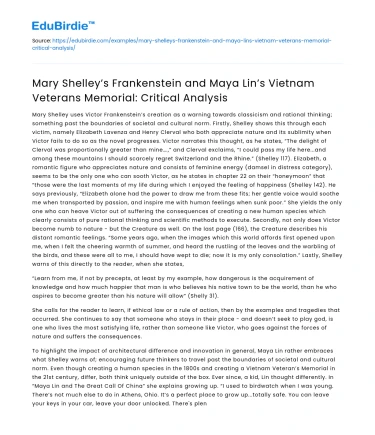Mary Shelley uses Victor Frankenstein’s creation as a warning towards classicism and rational thinking; something past the boundaries of societal and cultural norm. Firstly, Shelley shows this through each victim, namely Elizabeth Lavenza and Henry Clerval who both appreciate nature and its sublimity when Victor fails to do so as the novel progresses. Victor narrates this thought, as he states, “The delight of Clerval was proportionally greater than mine….,” and Clerval exclaims, “I could pass my life here...and among these mountains I should scarcely regret Switzerland and the Rhine.” (Shelley 117). Elizabeth, a romantic figure who appreciates nature and consists of feminine energy (damsel in distress category), seems to be the only one who can sooth Victor, as he states in chapter 22 on their “honeymoon” that “those were the last moments of my life during which I enjoyed the feeling of happiness (Shelley 142). He says previously, “Elizabeth alone had the power to draw me from these fits; her gentle voice would soothe me when transported by passion, and inspire me with human feelings when sunk poor.” She yields the only one who can heave Victor out of suffering the consequences of creating a new human species which clearly consists of pure rational thinking and scientific methods to execute. Secondly, not only does Victor become numb to nature - but the Creature as well. On the last page (166), the Creature describes his distant romantic feelings. “Some years ago, when the images which this world affords first opened upon me, when I felt the cheering warmth of summer, and heard the rustling of the leaves and the warbling of the birds, and these were all to me, I should have wept to die; now it is my only consolation.” Lastly, Shelley warns of this directly to the reader, when she states,
“Learn from me, if not by precepts, at least by my example, how dangerous is the acquirement of knowledge and how much happier that man is who believes his native town to be the world, than he who aspires to become greater than his nature will allow” (Shelly 31).
Save your time!
We can take care of your essay
- Proper editing and formatting
- Free revision, title page, and bibliography
- Flexible prices and money-back guarantee
She calls for the reader to learn, if ethical law or a rule of action, then by the examples and tragedies that occurred. She continues to say that someone who stays in their place - and doesn’t seek to play god, is one who lives the most satisfying life, rather than someone like Victor, who goes against the forces of nature and suffers the consequences.
To highlight the impact of architectural difference and innovation in general, Maya Lin rather embraces what Shelley warns of; encouraging future thinkers to travel past the boundaries of societal and cultural norm. Even though creating a human species in the 1800s and creating a Vietnam Veteran’s Memorial in the 21st century, differ, both think uniquely outside of the box. Ever since, a kid, Lin thought differently. In “Maya Lin and The Great Call Of China” she explains growing up. “I used to birdwatch when I was young. There’s not much else to do in Athens, Ohio. It’s a perfect place to grow up...totally safe. You can leave your keys in your car, leave your door unlocked. There's plenty of room.” But she never fit in.
“Everyone was worried about getting As and Bs and Cs. I really thought it was silly, kind of stupid . . .All the boys and girls were interested in one another, all taking themselves so seriously.
The girls were very into makeup . . . It was just not at all my idea of life, of anything interesting.” Author Phil Mccombs says her individualism expressed itself in her clothes, and it still does, as she went around Washington in “a pink-and-white dress, purple bush jacket and gray felt porkpie hat with a black band.” He continues: Athens never felt like home. 'My parents don't consider Athens [and] I grew up with their feelings. I don't feel like I have a home . . . As a result, I drift . . . Yale was the first place I felt comfortable.” Due to Lin’s success, she can be viewed as a role model, and with this image, she chooses to promote individuality, expression, and passion for her path, even if the Vietnam Veteran’s Memorial may have been deemed “disruptive innovation” initially, as it proves of something much more.
In conclusion, Mary Shelley’s Frankenstein and Maya Lin’s Vietnam Veterans Memorial redefine standards for travelling past societal and cultural norms as well as the impact level of divergent innovation with positive intent on negative outcome, and vice versa. To stress rightful means, both in the professional and ethical sense of intent versus outcome, Shelley employs use of narrative remorse and responsibility which makes incapable to assign blame on one particular side. Lin uses the element of continuity through her piece to suggest that positive intent does eventually outweigh a negative outcome, but also, that there may never be a fixed outcome as it shifts with social standards rather than the piece itself. While evaluating the impact of architectural difference and innovation in general, Shelley warns future designers of travelling past boundaries such as rational and classical thinking, and Lin encourages future thinkers to rather embrace difference and travelling past those boundaries of societal and cultural norm.






 Stuck on your essay?
Stuck on your essay?

